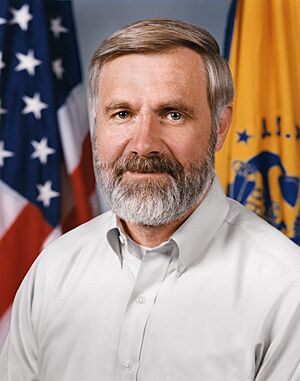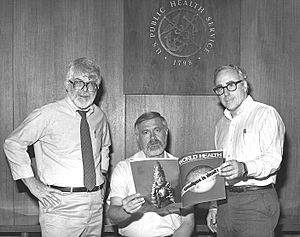William Foege facts for kids
Quick facts for kids
William Foege
|
|
|---|---|
 |
|
| 10th Director of the Centers for Disease Control and Prevention | |
| In office May 1977 – 1983 |
|
| President | Jimmy Carter Ronald Reagan |
| Preceded by | David Sencer |
| Succeeded by | James Mason |
| Personal details | |
| Born | March 12, 1936 Decorah, Iowa, U.S. |
| Spouse | Paula Foege |
| Education | Pacific Lutheran University (BA) University of Washington (MD) Harvard University (MPH) |
| Awards | Calderone Prize (1996) Conrad N. Hilton Humanitarian Prize |
William Herbert Foege (born March 12, 1936) is an American doctor and expert in public health. He is famous for creating the plan that helped get rid of smallpox around the world in the late 1970s. From May 1977 to 1983, Dr. Foege was the director of the Centers for Disease Control and Prevention (CDC).
Dr. Foege also played a big part in increasing how many people got vaccines in developing countries during the 1980s. In June 2011, he wrote a book called House on Fire: The Fight to Eradicate Smallpox. This book is about how science, medicine, and public health worked together to defeat smallpox.
In September 2020, he wrote a private letter to the CDC Director, Robert R. Redfield. In the letter, he asked the CDC to admit they had not handled the COVID-19 pandemic well. He also urged them to change their approach to leading the United States' response.
Contents
William Foege's Early Life
William Foege was born on March 12, 1936, in Decorah, Iowa. He was the third of six children. His father, William A. Foege, was a Lutheran minister. His mother was Anne Erika Foege. The family lived in Eldorado, Iowa, starting in 1936. They later moved to Chewelah, Washington, in 1945.
When he was younger, Dr. Foege was inspired by his uncle. His uncle was a Lutheran missionary in New Guinea. Dr. Foege became interested in science at age 13 while working at a pharmacy. He read many books about the world, including Albert Schweitzer's work in Africa. He did a lot of reading while he was in a body cast for several months at age 15. As a teenager, he wanted to practice medicine in Africa.
William Foege's Education
Dr. Foege earned a Bachelor of Arts degree from Pacific Lutheran University in 1957. He then went to medical school at the University of Washington. There, he became interested in public health by working at the Seattle–King County Health Department. After getting his medical degree in 1961, he completed an internship at a United States Public Health Service hospital in Staten Island.
From 1962 to 1964, he was part of the Epidemic Intelligence Service (EIS) at the Centers for Disease Control and Prevention (CDC). He was assigned to Colorado. During his time with the EIS, he was inspired to work in global health. He also spent a short time with the Peace Corps in India. Later, he joined the Master of Public Health program at the Harvard School of Public Health. He received his Master of Public Health degree in 1965.
How Smallpox Was Eradicated
While working for the Centers for Disease Control in Africa, Bill Foege led the Smallpox Eradication Program. He created a very successful plan called "surveillance and ring vaccination". This plan helped stop smallpox from spreading. It meant fewer vaccines were needed, so the limited supplies were enough. Because of this, smallpox became the first infectious disease in history to be completely wiped out in humans.
For his work to get rid of smallpox, Dr. Foege shared the 2020 Future of Life Award with Viktor Zhdanov. António Guterres, the Secretary General of the United Nations, said that everyone owes a lot to Bill Foege and Viktor Zhdanov. He noted their important work showed how valuable science and teamwork are in fighting diseases. Bill Gates also praised them, saying they are great examples of using science for global health.
William Foege's Career
Dr. Foege's work has focused on many important health areas. These include helping children survive and grow, preventing injuries, and improving public health leadership, especially in developing countries. He strongly believes in getting rid of and controlling diseases. He has actively worked to eradicate Guinea Worm Disease, polio, and measles. He also helped eliminate river blindness.
In May 1977, he became the director of the Centers for Disease Control and Prevention. He served in this role until 1983.
Besides being director, he has held many other important jobs:
- President and co-founder of The Task Force for Global Health, from 1984 to 1999.
- Senior Fellow for the Global Health Program at the Bill & Melinda Gates Foundation.
- Advisory Board Member for the Emory University Global Health Institute.
- Professor Emeritus at the Rollins School of Public Health.
- Health Policy Fellow at The Carter Center, from 1986 to the present.
- Executive Director of The Carter Center, from 1986 to 1992.
Personal Life
Dr. Foege is known for being very tall, about 6 feet 7 inches. He and his wife, Paula, had three sons. Sadly, their oldest son passed away in 2007. Dr. Foege has been described as a religious man. From 1997 to 2006, he served on the Board of Regents for Pacific Lutheran University.
Awards and Honors
Dr. Foege has received many awards and honors for his important work:
- Abraham Lilienfeld Award, 1990
- Fries Prize for Improving Health, 1992
- Sedgwick Memorial Medal, 1993
- Frank A. Calderone Prize, 1996
- Honorary Doctor of Science from Harvard University, 1997
- Mary Woodard Lasker Award for Public Service, 2001
- Public Welfare Medal from the United States National Academy of Sciences, 2005
- Albert B. Sabin Gold Medal, 2006
- The William H. Foege building at the University of Washington School of Medicine was named in his honor in 2006.
- Jimmy and Rosalynn Carter Award for Humanitarian Contributions to the Health of Humankind, 2007
- Chosen as one of "America's Best Leaders" by U.S. News & World Report, 2007
- Ivan Allen Jr. Prize for Social Courage, 2012
- Presidential Medal of Freedom, 2012
- 2020 Future of Life Award (for Smallpox Eradication)


